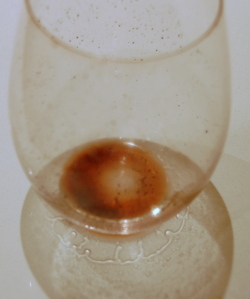Mamma mia, was about all I could think to gasp when I was presented with a bottle of Grandma Maria’s, a non-vintage sangiovese/cabernet sauvignon blend bearing the over-utilized Toscana IGT locator.
The price: a cool $3.99. The label: a corpulent nonna (presumably of the Italian-American persuasion because the Old World version generally isn’t, and doesn’t use oven mitts, either) stirring an enormous (again, by Italian standards) cauldron of red sauce on a background of the ubiquitous checkered vinyl tablecloth.
Before I could hurl it away (or was that just hurl?), I thought, WTF? I’ve got nothing better to do tonight. I’ll give the bottle a twist, and see what comes out.
Normally, I’m not so sanguine about obvious gimmicky hooks, be they in the wine world or any of the other worlds that us consumers inhabit. I’ve spent a lot of my life convinced that unlike the rest of you suckers, Madison Avenue holds no sway over me (I’ve never even watched an “American Idol” trailer, much less an episode). I will, however, concede that making such a statement probably has the Mad Men winking in the knowledge that I’m theirs, just in a different way.

So as to not engage in any revisionist history, here’s what I jotted down. Verbatim, I think I’m ashamed to say. Nose: “dusty, cedary, classic S[angiovese], dried tobacco, hint of shy red berry.” Mouth: “raspy, citrusy acidity, not getting the C[ab], pretty good balance, tart dried berries.”
Luckily, I’m no longer obligated to score wines, so I needn’t risk getting kicked out of the I’m-an-expert-taster club. The bottom line was this thing wasn’t half bad. In fact, it wasn’t at all bad in any way, shape or form. Yikes.
It feels good to admit it. Sort of. Because for all the egalitarian talk these days about wine, at the end of the day, don’t us “experts” secretly harbor very reactionary wine preferences? I know I do. Give me Krug, or give me an unhappy life. I prefer my claret to be decidedly of the classified variety (not to mention hailing from Pauillac). It’s true that I represent teeny, tiny producers, none of whom would ever be mistaken for a Screaming Eagle (in reputation, that is). But at the same time, don’t your salivary glands and nose hairs get a bit excited when contemplating a sniff then sip of Haut-Brion or Grange or DRC? Particularly, if you’re not footing the bill.
Grandma Maria’s actually nicely represents two polarities I have never been able to reconcile. Until now, that is.
First pole: This is the golden age of winemaking. It’s almost literally impossible to make bad wine at the commercial level. And when I mean “bad,” I mean wine that is not capable of being swallowed. I don’t care what anyone says, that animal is extinct (though its epoch was not that long ago).
The flip side of no longer having to worry about gagging when swallowing (yes, I know that’s an inappropriate image) is that there are literally oceans of technically correct and wholly uninteresting wine out there. Couple that with new appellations coming on line almost daily and the proliferation of new labels, and today’s consumer is burdened like never before when making (or trying to make) informed choices.
I give PV383/IT credit for coming up with its concept and making this wine. Yes, that is the “producer.” It says so on the label. In other words, no suggestion about an ancestral home in the rolling Chianti Hills. Nor a weepy multigenerational commitment to the art of the vine. Just a solidly made, if not moving, red. How’s this for no bullshit in marketing? The back label actually has a meat-based pasta sauce recipe on it under the heading, “Cooking with Grandma Maria.” Truth in advertising. Nice concept.
I’m not actually reconciling the fact that all wine is well made, though much of it is not interesting. Just that I’m finally OK with it.
All of which just proves that the more I know about wine, really, the more I don’t.